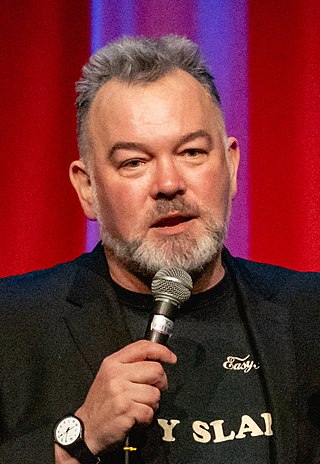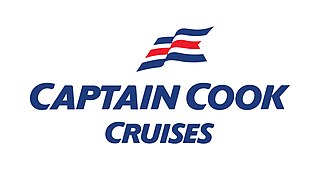Related Research Articles

Tuvalu, formerly known as the Ellice Islands, is an island country in the Polynesian subregion of Oceania in the Pacific Ocean, about midway between Hawaii and Australia. It lies east-northeast of the Santa Cruz Islands, northeast of Vanuatu, southeast of Nauru, south of Kiribati, west of Tokelau, northwest of Samoa and Wallis and Futuna, and north of Fiji.

Stewart Graham Lee is an English comedian. His stand-up routine is characterised by repetition, internal reference, and deadpan delivery.

The Coral Sea is a marginal sea of the South Pacific off the northeast coast of Australia, and classified as an interim Australian bioregion. The Coral Sea extends 2,000 kilometres (1,200 mi) down the Australian northeast coast. Most of it is protected by the French Natural Park of the Coral Sea and the Australian Coral Sea Marine Park. The sea was the location for the Battle of the Coral Sea, a major confrontation during World War II between the navies of the Empire of Japan, and the United States and Australia.

The crown-of-thorns starfish, Acanthaster planci, is a large starfish that preys upon hard, or stony, coral polyps (Scleractinia). The crown-of-thorns starfish receives its name from venomous thorn-like spines that cover its upper surface, resembling the biblical crown of thorns. It is one of the largest starfish in the world.

Vanua Levu, formerly known as Sandalwood Island, is the second largest island of Fiji. Located 64 kilometres to the north of the larger Viti Levu, the island has an area of 5,587.1 square kilometres (2,157.2 sq mi) and a population of 135,961 as of 2007.

The Pacific reef heron, also known as the eastern reef heron or eastern reef egret, is a species of heron found throughout southern Asia and Oceania. It occurs in two colour morphs with either slaty grey or pure white plumage. The sexes are similar in appearance.
The Lau Islands of Fiji are situated in the southern Pacific Ocean, just east of the Koro Sea. Of this chain of about sixty islands and islets, about thirty are inhabited. The Lau Group covers a land area of 188 square miles, and had a population of 10,683 at the most recent census in 2007. While most of the northern Lau Group are high islands of volcanic origin, those of the south are mostly carbonate low islands.

Wakaya is a privately owned island in Fiji's Lomaiviti Archipelago. Situated at 17.65° South and 179.02° East, it covers an area of 8 square kilometres (3.1 sq mi). It is 18 kilometres (11 mi) to the east of Ovalau, the main island in the Lomaiviti Group. Two other islands close to Wakaya are Makogai to the north, and Batiki to the south-east.

Conway Reef, known since 1976 by its Fijian name Ceva-I-Ra Reef, is a coral reef of the atoll type.

Cayo Largo del Sur, or simply Cayo Largo, is a small resort island in Cuba, off the south coast of the northwestern part of the main island in the Caribbean Sea. The cay is about 25 kilometers (16 mi) long and 3 kilometers (1.9 mi) wide and is the second largest island in the Canarreos Archipelago. Cayo Largo is part of the special municipality of Isla de la Juventud.
"Where or When" is a show tune from the 1937 Rodgers and Hart musical Babes in Arms. It was first performed by Ray Heatherton and Mitzi Green. That same year, Hal Kemp recorded a popular version. The song also appeared in the film version of Babes in Arms two years later.
Richard Randolph "Randy" Olson is a marine biologist-turned-filmmaker who earned his Ph.D. in Biology from Harvard University (1984) and became a tenured professor of marine biology at the University of New Hampshire (1992) before changing careers by moving to Hollywood and entering film school at the University of Southern California.
Noel Ferrier AM was an Australian television personality, comedian, stage and film actor, raconteur, and theatrical producer. He had an extensive theatre career which spanned over fifty years.
The Tasmanian Football Hall of Fame was established to help recognise outstanding services and overall contribution made to the sport of Australian rules football in Tasmania. Any participant of the sport, including players, umpires, media personalities and coaches, may be inducted. A physical hall was established in 2005 after the Tasmanian Community Fund provided a $50,000 grant to assist AFL Tasmania and the Launceston City Council with establishment of a permanent facility at York Park. The decision to locate the Hall of Fame at the ground was because the site had recently been redeveloped and was positioned as the "true home of Tasmanian football". AFL Tasmania initiated the Hall of Fame nomination process, with a number of clubs, players and grounds nominated and accepted into the Hall of Fame since 2005. The public Hall of Fame opened to the public on Saturday 21 February 2009.

The Siege of Pinchgut is a 1959 British thriller filmed on location in Sydney, Australia, and directed by Harry Watt. It was the last film produced by Ealing Studios, and was entered into the 9th Berlin International Film Festival where it was nominated for the Golden Bear Award.
Eliza Fraser is a 1976 Australian bawdy adventure drama film, directed by Tim Burstall and starring Susannah York, Trevor Howard, Noel Ferrier and John Castle. The screenplay was written by David Williamson.
Noel Monkman (1896–1969) was an Australian filmmaker, born in New Zealand, best known for specialising in underwater photography. He was a press photographer in New Zealand before moving to Australia and jointing the Orpheum Theatre orchestra.
Timothy James Gordon Eliott was a New Zealand actor.

Captain Cook Cruises is an Australian cruise operator. As of January 2018, the company operated 21 vessels on Sydney Harbour, providing a range of Government contracted and non-contracted Ferry services, Sightseeing, Dining and Charter Cruises.

Climate change in Fiji is an exceptionally pressing issue for the country - as an island nation, Fiji is particularly vulnerable to rising sea levels, coastal erosion and extreme weather. These changes, along with temperature rise, will displace Fijian communities and will prove disruptive to the national economy - tourism, agriculture and fisheries, the largest contributors to the nation's GDP, will be severely impacted by climate change causing increases in poverty and food insecurity. As a party to both the Kyoto Protocol and the Paris Climate Agreement, Fiji hopes to achieve net-zero emissions by 2050 which, along with national policies, will help to mitigate the impacts of climate change.
References
- 1 2 3 Andrew Pike and Ross Cooper, Australian Film 1900–1977: A Guide to Feature Film Production, Melbourne: Oxford University Press, 1998 p273
- ↑ "Australian Films At the Australian Box office" (PDF). Film Victoria. Archived from the original (PDF) on 9 February 2014. Retrieved 28 September 2012.